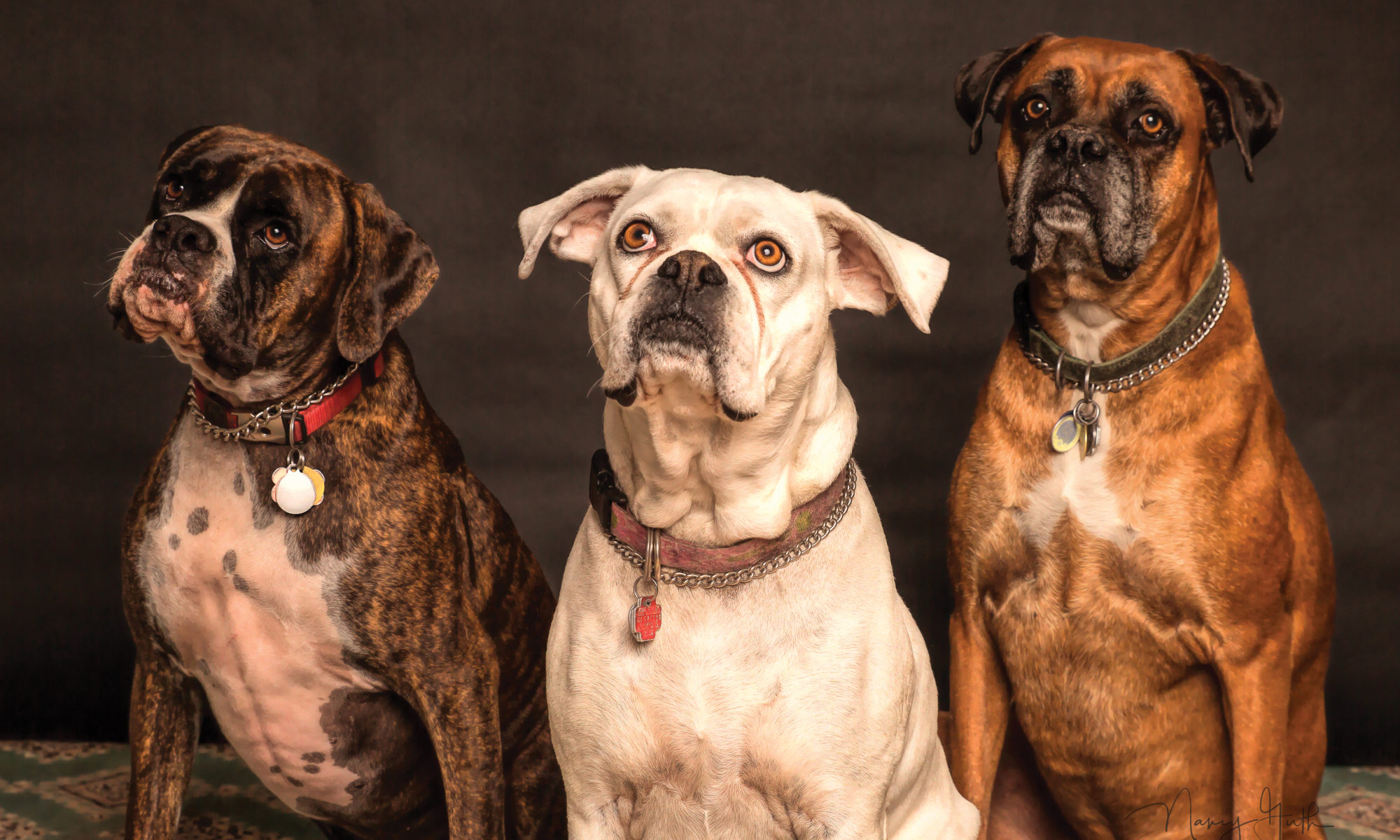Years ago, there was little to choose from in dog training techniques. If you were searching for a training program you were offered the choice between metal choke and/or prong collars or sometimes cloth choke collars. Trainers used harsh corrections often followed by food or praise. If you were lucky you found a trainer who advocated somewhat more modest corrections – but still with the use of choke and/or prong collars. If you were even more fortunate you found a trainer who used that cloth choke collar on the dead (or non-correction giving) ring. It was the rare trainer who advocated any sort of positive training.
Thankfully, times have changed and there is a wide array of training techniques from which to choose. This is a very good thing because training your dog is a very important thing to do. Dogs need training so they can properly and comfortably fill their places in our lives and families. The techniques used to train them must be pleasing to the owner. The owner must be motivated, willing and comfortable using those techniques or the dog will not be trained. If you as the owner are uncomfortable with the techniques offered, you are less likely to use them, perhaps even dropping out of the classes altogether. Often, this is enough to sour the owner on training the dog at all. As we all know, an untrained dog makes for an unhappy dog, an unhappy owner – and probably unhappy people who find themselves interacting with that dog.
Techniques
Positive reinforcement: There are no corrections. The dog is motivated by food, toys and praise. Each dog will have his/her own best motivator and the owner/trainer works to find it to best motivate the dog in training. The owner/trainer works to manage the dog so that the dog does not have the opportunity to perform/get away with bad or unwanted behaviors. If the management should lapse and the dog does “get away with one”, the owner/trainer does not react in any negative fashion. The owner/trainer does not do anything to draw attention to the behavior in any fashion. Once the behavior is past the owner/trainer goes on from there and works harder to manage the dog to prevent future “mistakes”. The fewer mistakes the easier the training.
Semi-positive reinforcement[1]: This technique is a variation on positive reinforcement that allows appropriate “corrections” as part of the program. Management of the dog and its behavior is as paramount as it is in positive reinforcement. When management fails, should it fail, and the dog “gets away with one” the “appropriate” correction can be used. These “appropriate” corrections must befit the crime. The “correction” may be as simple as “eh eh” – a sort of “growl”, a gentle but firm “no” or some other similar thing to draw the dog’s attention to the fact that it has erred. Then, once “corrected”, the dog is assisted in performing the proper behavior after which the owner/trainer redoubles efforts to achieve management of the dog so that the dog does not “get away with” that inappropriate behavior(s) or any others.
Semi-positive reinforcement means that you find ways of managing the dog so it does not make a mistake. It means that you try to teach the dog the right way so that you don’t have to “unteach” the wrong way. It means that you use a lot of patience and ingenuity. It means that you learn a lot about dog and other canid behaviors, body language and instincts so that you can make use of this knowledge in the training of the dog. It means training the dog with your heart and mind rather than anger, force, domination and fear.
Should the management fail and the dog make a mistake, the owner/trainer should identify the mistake by communicating with the dog using methods other than forceful ones such as jerking on its neck with a choke or prong collar. Again, the punishment/correction must befit the crime. Remember that it is the owner/trainer who has really failed, not the dog. The dog is just being a dog. If the owner/trainer’s management has failed the dog can and will make mistakes and it is incumbent on the owner/trainer to understand this and be fair in dealing with the results of his/her failure. The dog must not and should not suffer the consequences.
Punishment/Negative Training: This method involves collar corrections which may or may not be followed by food or verbal praise. It involves the use of choke collars, prong collars and sometimes electric shock collars.
Positively Randy! recommendations
Positively Randy! believes that it is the owner’s responsibility to do research into the available training techniques and decide as to his/her preferences for technique before signing up for a training program. The owner is the dog’s protector, advocate, pack leader and “parent”. It’s up to the owner to ensure that the dog is treated fairly. This can (and should) be done with a combination of reading, internet searches and visitations to local training business to see training in action.
In addition, just as you would for your human child, it is imperative to check out schools and programs to which you might send your dogs. The owner should check with their veterinarian, the dog’s breeder, trusted family and friends re. programs they might have used and would recommend. The owner should research all programs, businesses and trainers that might be selected as the trainer of choice. It is very important to do the research to ensure selection of the best class for the owner and dog. This will maximize the probability of a successful training “campaign”.
Some of the questions to ask the prospective trainers are:
- What are the training techniques to be used?
- Where are the classes to be held?
- How many dogs per class will be accepted? How many instructors will there be per class?
- What is the dog to instructor ratio?
- Can I come to see a representative class?
- What items do I need to purchase/have available for the training classes?
- What is the policy on refunds, missed classes etc.? Any parameters like these should be understood before signing up for the classes.
- If you intend to give your dog to a trainer for training at his/her facility, these questions and others will be very important. You will be giving your dog to someone who will be training it out of your sight and you will have no control over what happens to your dog. Be certain you are comfortable with the trainer. Also, be sure to ask about how the trainer will address the question of transferring the techniques and information to you so you can learn how to work with the dog, how to ensure that the dog understands it must work for you as it did for the trainer and how you can further your dog’s education.
Final thoughts
Positively Randy! believes that the best way to train a dog is to manage the dog’s life and interactions so that there are few, if any, bad behaviors shown and learned. Yes, it’s that “simple”. The key to training is the management of the dog thus limiting the behaviors we do not want and maximizing those we do. Dogs learn by doing and if they cannot exhibit “bad” behaviors, they do not learn they can do them and we don’t have to worry about un-teaching those less than desirable behaviors. What the dog learns is what we want it to. Of course, as already stated, along with the management comes the training techniques and program.
So, management is the key. With good management, the owner will have fewer situations to address – perhaps none if the management is well done and effective. If there are lapses in management, the owner should not hesitate to tell your dog which behaviors are unacceptable. The owner should not hesitate to turn off those behaviors and replace them with others that are preferable. It will take time, energy and effort but nothing well done ever comes too easily. It will mean training in many different places to teach the dog that he must listen to you no matter what’s happening around him. It may mean finding children to expose him to so he isn’t frightened of them. It may mean exposing him to noises that frighten him. It may mean taking him in the car to help him overcome car sickness.
No one ever said training a dog would be easy; it’s hard work, no matter what method you use. If you aren’t willing to expend the effort, then you must be willing to put up with the dog you create. As the old obedience trainer’s saying goes: YOU ALWAYS END UP WITH THE DOG YOU DESERVE!
[1] True positive reinforcement is a training program that uses absolutely no corrections. It uses the strictest management of the dog to (hopefully) prevent problems from occurring. Semi-positive reinforcement is a Positively Randy! created and developed training technique/and philosophy that stresses management of the dog but allows for (appropriate) corrections of the dog’s mistakes. The corrections must befit the crime. This philosophy of semi-positive reinforcement will become clearer as we proceed through the nine weeks of class. Both positive and semi-positive training techniques are available and in use at Positively Randy!

